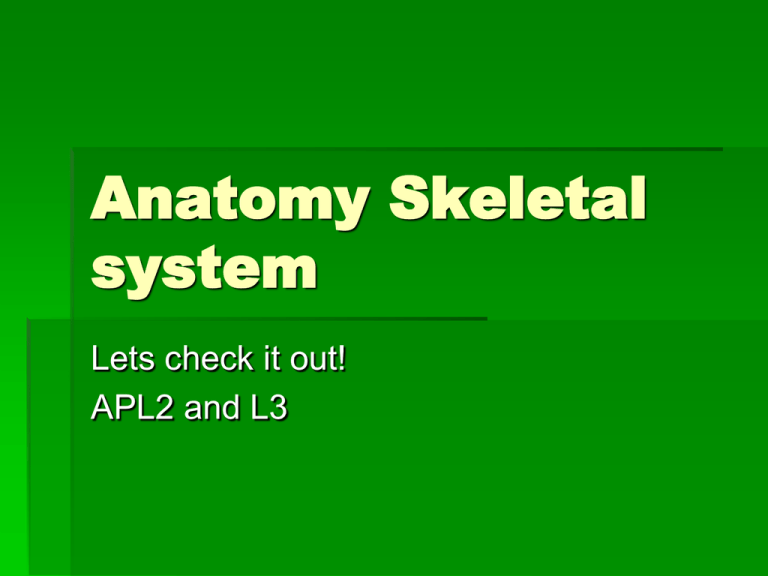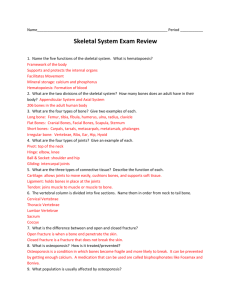Quick Quiz #1
advertisement

Anatomy Skeletal system Lets check it out! APL2 and L3 Axial vs Appendicular Skeleton (206 bones adult) Skull 22 bones connected by sutures (Fibrous joints) 8 bones of cranium + 14 facial bones At birth, sutures in process of formation & early joints called Fontanels (soft spots on head of newborn; allow compression of head as passes through birth canal) Fontanels replaced by immovable sutures as cranial bones grow together Vertebral column Strong flexible rod that supports the trunk and allows movement. Between 2 vertebrae is compressible mass of fibrocartilage called intervertebral discs Protects spinal cord Baby at birth: has a thoracic and sacral curves As begin to hold head= cervical curve develops. As begin to walk= lordotic curve develops Differences in Vertebral column Why are they different? Cervical Vertebrae First 2 cervical vertebrae have unique features to permit movement of head 1st is Atlas= has no body; it’s articulation with head permits up & down motion 2nd is Axis= has body with prominent process that projects upward through atlas; pivots to allow side to side motion of head (shaking head no) Thoracic Vertebrae 12 vertebrae; larger than cervical vertebrae Only members of vertebrae that articulate with ribs Lumbar Vertebrae Five lumbar vertebrae are larger & thicker to support increased body weight Sacrum & Coccyx Sacrum is a large triangular bone formed by fusion of 5 vertebrae Forms posterior part of the pelvis Coccyx is series of 3 to 5 small, fused or partially fused bones. Thoracic cage Where is posterior articulation What does it protect? Any potential problems? Parts of Appendicular Skeleton: Pelvic Girdle (3 bones) Pelvic Girdle= strong, durable frame; supports lower limbs & carries weight of the body. Three bones of the pelvis (illium, ischium, pubis) and the sacrum Three Joints SacroIlliac (SI) Pubis Symphysis Acetabulum Pelvic bone: (coxal bone or os coxae) Three non-distinct bones Center intersection is “socket” called acetabulum “Ball” is the head of the femur Quick Quiz #1: 2 pts each=14 1. What bones make up axial skeleton? 2. Why does a baby have fontanels? 3. Why are there kyphotic and lordotic curves in the mature vertebral column? 4. What is unique about C1 and C2? 5. List/describe rib cage by its using the 4 terms to describe the types. Quick Quiz: cont. 6. Explain the differences between male and female pelvis. (Give 4) 7. How does the anatomy of the female pelvis relate to its physiology? Upper Extremity (shoulder) How does it work? 1. Strong ligaments connect the ball of humerus and socket (cup) of scapula. 2. Cartilage on head of humerus and joint fluid allows smooth gliding, no friction 3. Deltoid and rotator cuff muscles and their tendons help with this joint. Shoulder Injuries: 1. Shoulder is most moveable joint in body 2. Easily dislocated because: ball of upper arm greater than socket that holds it. 3. Must be repaired by a reduction Hand Phalanges (fingers) Metacarpals (body of hand) Carpals (wrist) Foot Talus (ankle) Tarsals – includes Calcaneus (heel), & series of bones Metatarsals- instep Phalanges (toes) Types of Joints (Articulation) Joint: Union of 2 or more bones attached primarily by ligaments Union results in Free movement (Synovial) Semi or little movement (Cartilaginous) No movement (Fixed; Fibrous) A. GLIDING (PLANE) JOINT - Permits a sliding motion of one bone over another. Found at the ends of the collarbones, between wrist bones, and between anklebones, SI joint, and between ribs 2-7 and sternum. B. SADDLE JOINT - Permits movement in two planes. This type of joint is found at the base of the thumb. C. HINGED JOINT - Permits a back-and-forth motion. The Knee enables your leg to flex and extend. The Elbow, which allows you to move your forearm forward and backward. Also within joints of phalanges. D. PIVOT JOINT - Permits rotation of one bone around another. The elbow enables your hand to turn over. It also allows you to turn your head from side to side. E. BALL AND SOCKET JOINT - circular movement - the widest range of movement. THE SHOULDER Joint, which enables you to move your arm up, down, forward and backward, as well as to rotate it in a complete circle. F. Elipsoid/Condyloid JOINT - Allows for a hinge type movement in two directions. The joints that connect fingers with the palm and toes with the soles of feet and mandibular condyl with the fossa on skull. Types of Freely Moveable Joints Knee Joint Knee has discs of fibrocartilage (menisci)= increase stability of joint Ligaments connect the bones Synovial Joint Ligament (fibrous) Synovial fluid Articular cartilage Periosteum Articular Capsule made up of: 1. fibrous capsule 2. Synovial membrane What is Rheumatoid Arthritis? chronic, long term swelling leading to permanent LOF & disability Swelling of the synovial lining (membrane) Chronic swelling of joint leads to thickening of synovium. What is the cause and how do I get rid of it? Autoimmune disease (not completely understood) Systemic, affecting multiple joints of the body. Usually it is bilateral. Causes a lot of pain Early, aggressive TX may limit joint damage= NSAID’s, corticosteroids, gold. Currently, Methotrexate has replaced gold as a treatment overall. Rheumatoid Epidemiology Typical age of onset is 30-50 y.o. More than 70% of are female Interestingly, RA often goes into remission during pregnancy, worsened after pregnancy. Men tend to get worse cases though not as often Osteoarthritis (degenerative arthritis) Cause= often from repetitive use of joints/or injury Breakdown and eventual loss of cartilage in one or more joints Commonly affects hands, feet, spine, and large-weight bearing bones. In US, affects all races equally. After age 55: more common in Females Prior to age 45: more common in Males WHY, WHY, WHY ???? Symptoms of Osteoarthritis May vary with patient/severity, but unlike RA, OA is limited to the affected joint(s). Usually pain, swelling, & stiffness develop and progress throughout the day. Long periods of inactivity (movie theaters) Common areas of OA Weight-bearing Non-weight bearing joints Carpal & metacarpal Knee & Hip- leads to joints in hands total joint Boney nodules (bone replacement spurs) decrease Joint of big toe- leads function to bunions Vertebrae- leads to bone spurs that irritate nerve endings Treatment = osteo NSAIDS, Tylenol, other pain meds. Nutritional supplements: glucosamine Exercise and physical therapy Treatment for injuries Surgical repair: Arthroscopy uses camera and probes to repair damaged tissue. Closed surgery decreases healing Open repair: total joint replacement. Only lasts 15 years or so Quick Quiz #2 total:18 pts 1.Describe the shoulder joint in terms of the anatomy (3 structures that assist in physiology of it) 2.Why are shoulder injuries so common? 3.What are the 3 types of joints and describe each? 4.Describe 4 of the 6 types of synovial joints and give a location for each Quick Quiz #2 cont: 5. Describe 4 structures of the knee joint (location and how they assist the joint) 6.What is a sprain? Strain? 7.Describe 3 structures in a basic synovial joint. 8.How does each assist in physiology of it? 9.Rheumatoid VS Osteoarthritis: give symptoms, cause, who gets it, treatments for each







